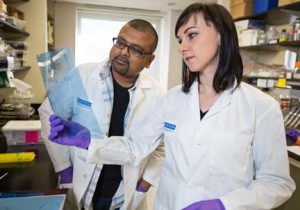By Andrew Clark

Kartik Chandran ’95 reviews data with a colleague. Photo courtesy Albert Einstein College of Medicine
A team of researchers led by Kartik Chandran ’95 managed to break open Ebola’s previously elusive mechanism for entering a cell.
“It’s a first step toward a therapeutic,” said Chandran in “Race for a Cure,” Newsweek (Aug. 6, 2012). “We have a bona fide target.”
The discovery was described in two articles by Chandran and his colleagues in Nature and also publicized by Reuters and other media. His lab received a $4.8 million grant from the National Institutes of Health in support of the research.
Chandran, associate professor of microbiology and immunology at Albert Einstein College of Medicine, hopes to develop an anti-Ebola therapeutic within five to six years. He works collaboratively with about a half-dozen scientists around the world, including Uganda.
Perfect timing
Identified in Africa in 1976, Ebola virus causes severe hemorrhagic fever in humans and other primates, such as monkeys and gorillas, with a fatality rate of nearly 90 percent. It is unknown how the virus spreads, and no vaccines or drugs are available to fight the infection.
Nearly a decade ago, important discoveries about the virus began to emerge. For Chandran, who was deciding on his career specialty, the timing was perfect.
“Scientists had just figured out how to work with this dangerous virus without having to wear a spacesuit,” he says.
Pursuing a dream
Growing up in India, he dreamed of going to America to pursue a career as a research scientist.
“Lafayette took a chance on a 17-year-old from India and that made everything possible for me,” says Chandran, a biochemistry graduate who went on to earn a doctorate in biochemistry at University of Wisconsin.
He says his participation in the EXCEL Scholars undergraduate research program was invaluable for his later success and notes two professors who were particularly influential–David Husic, Larkin Professor of Chemistry and head of the department, and Valerie Walters, former associate professor of chemistry.

1 Comment
Comments are closed.